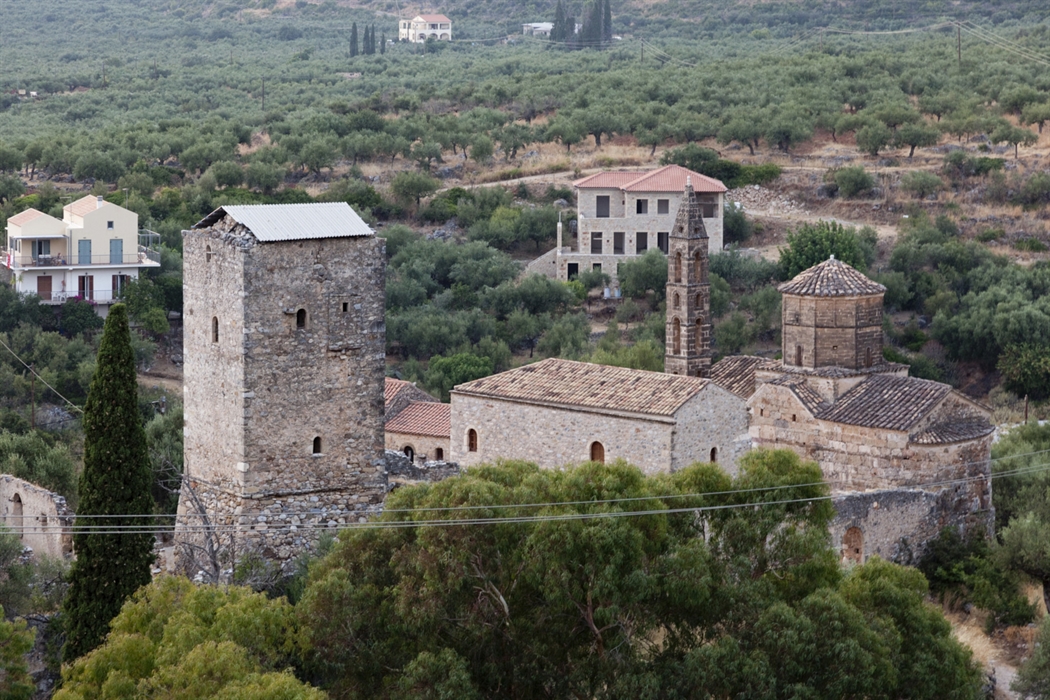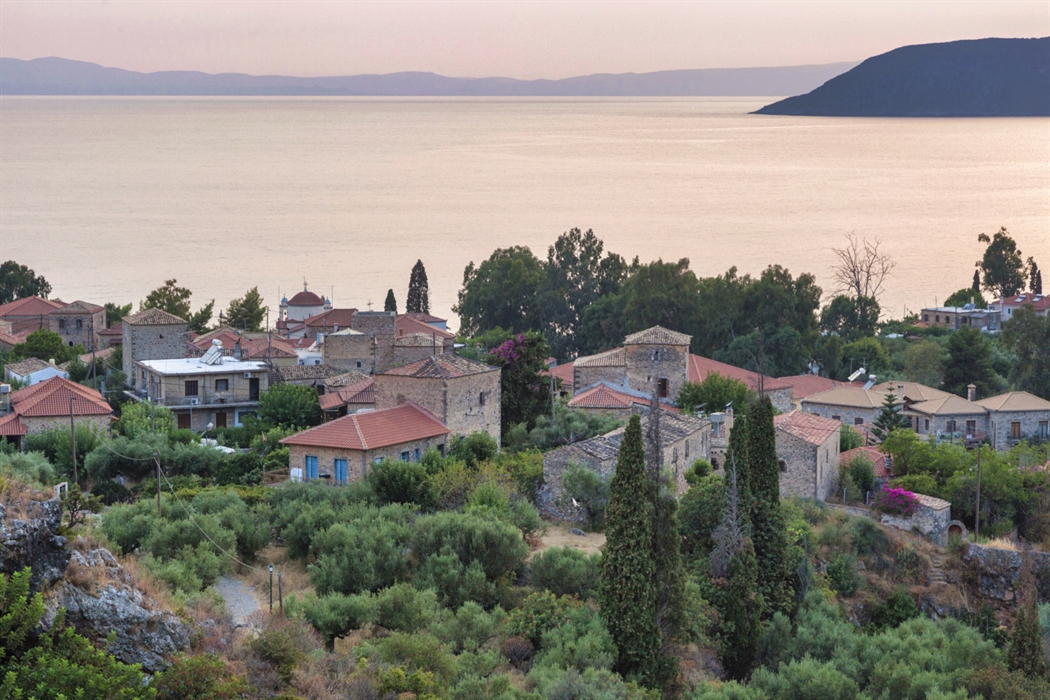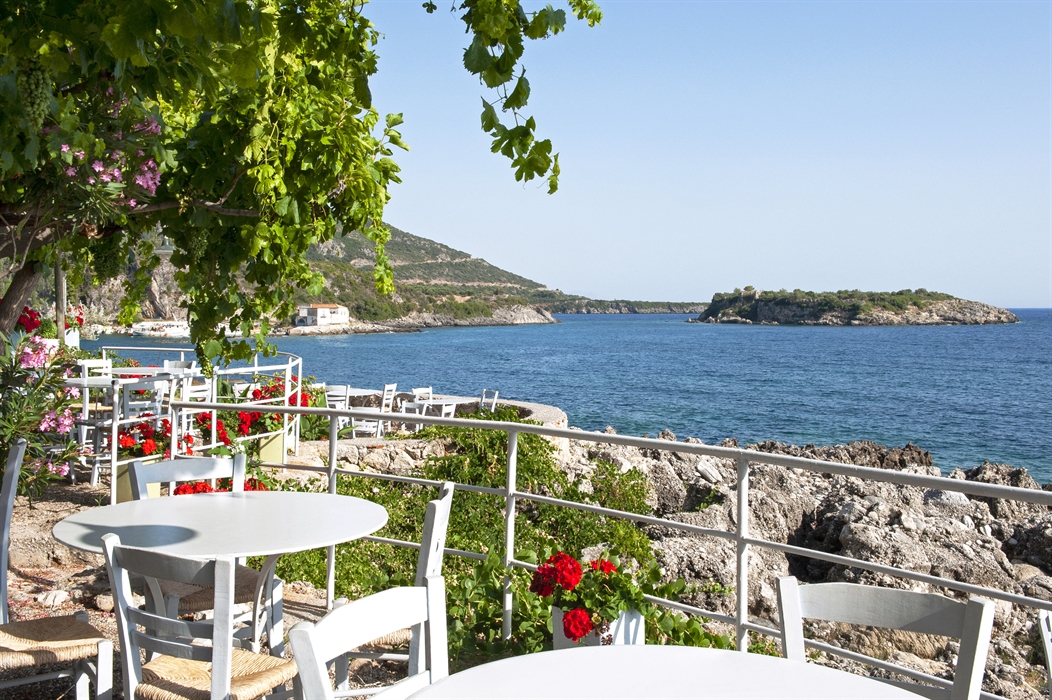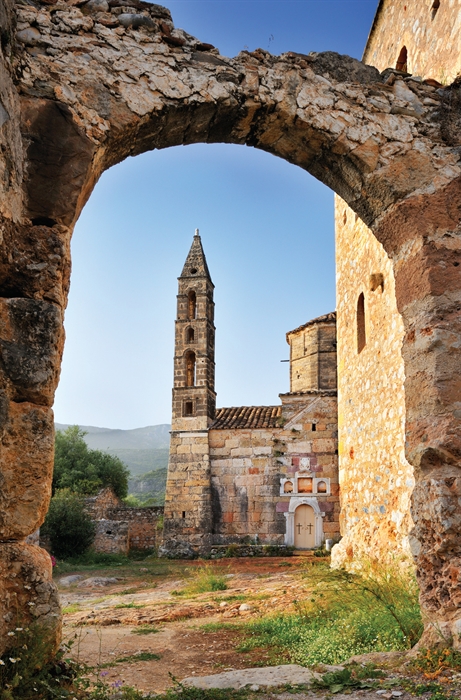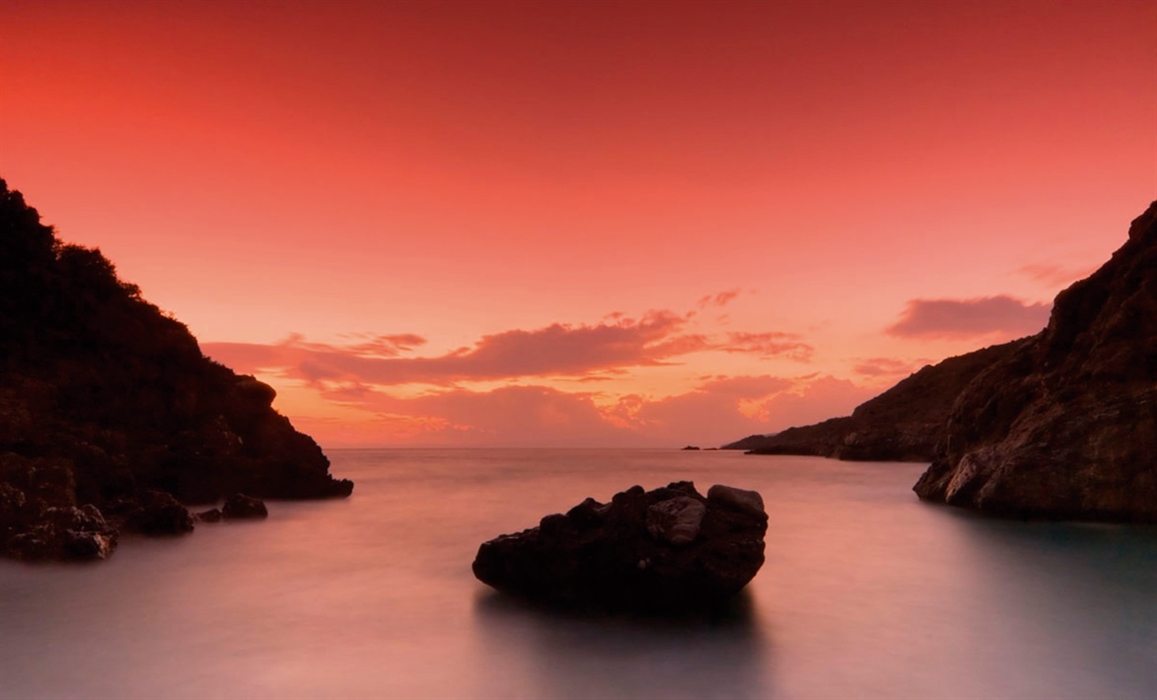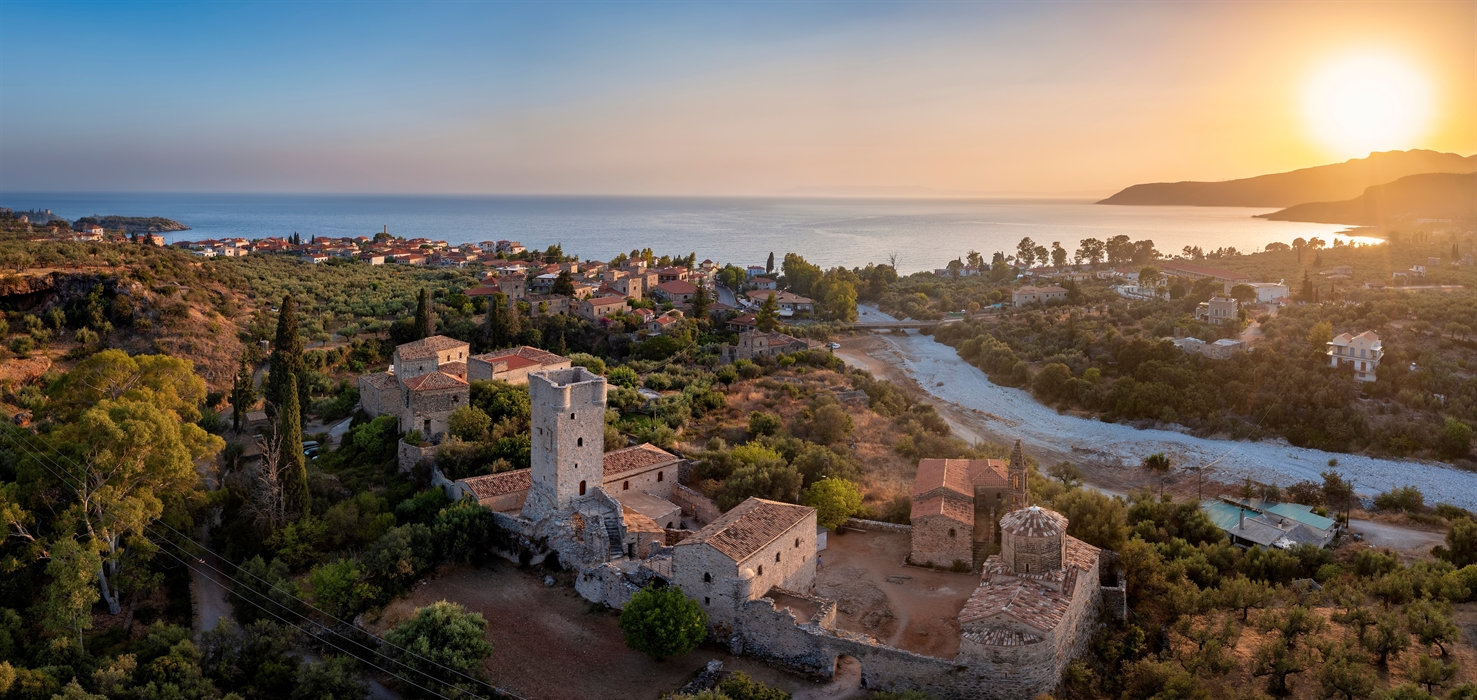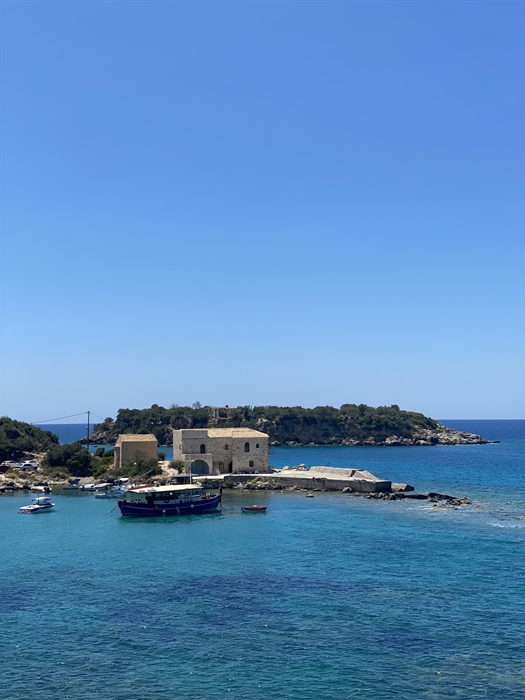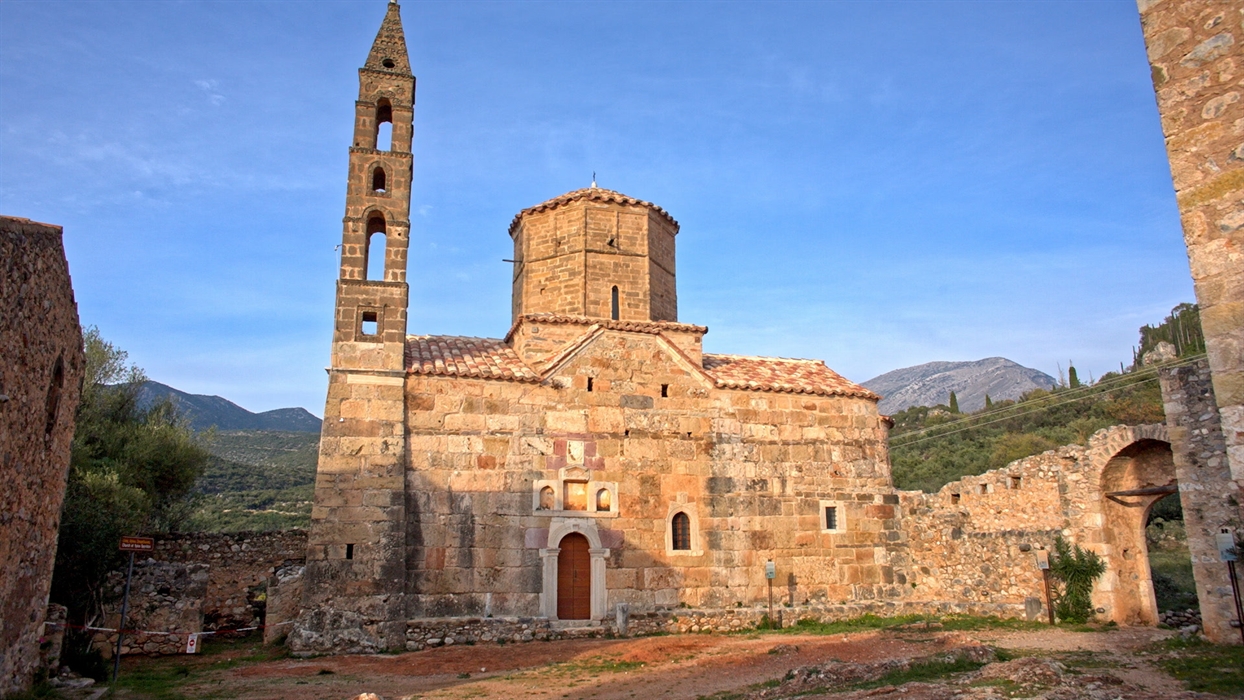Kardamyli
Built on the Messinian Gulf Kardamyli has been named as one of the most beautiful villages in Europe, and if you are lucky enough to spend some time there you’ll immediately realize why! It’s the most glamorous summer destination in Exo Mani, it’s got a great beach, the surrounding countryside is stunning and the old stone-built houses with their gardens lend an air of old-world charm. You can also visit the fortified Troupakis-Mourtzinos complex in Old Kardamyli which operates as a museum.
Travel & Leisure magazine included Kardamyli in its list of the most beautiful villages in Europe, and if you are lucky enough to spend some time there you’ll immediately see why. It’s a small village with stone-built houses and tiled roofs, most of them built in the characteristic Maniot architecture, set in a sea of olive trees. Mount Taygetus rises impressively behind the village, and the streets lead down to the Messinian gulf.
Kardamyli is the biggest seaside settlement in Exo Mani, and has been hosting tourists for many years, always providing excellent quality services. There are three districts, Palia Kardamyli, Kato Kardamyli and Skala. Wherever you stay you will enjoy wandering around the village looking at the courtyards and gardens full of flowers, vines and jasmine. In Tikla area, right above the rocks, you can visit the elegant tavernas, all day restaurants and cafes.
Make time to visit Palia Kardamyli and see the Troupakis-Mourtzinos fortified complex which is now a listed monument: It’s always good to learn a bit more about the place you are staying in, and this complex of buildings is home to a museum where you can do just that. The buildings themselves are fascinating, with an impressive Maniot tower-house, a fortified residence, auxiliary buildings and the church of Agios Spyridon (18th century). The main core of the complex has been built in different phases -from the end of the 17th to the 19th century. The view is an extra bonus, as you can look out over the trees and across the village rooftops to the sea.
There is a permanent exhibition in the tower house which includes maps, drawings, engravings, photographs and models of the village. However, when it comes down to it, the whole complex is an exhibit and you’ll find information on all the buildings -the tower, the cistern, the temple, the vegetable garden, the olive press and the forge. Temporary exhibitions are also held in the complex. (Tel. 27210 73638).
Near the Troupakis-Mourtzinos complex is the "tomb of Castor and Pollux ". As local tradition tells us Helen of Troy’s twin brothers were buried there.
BRIEF HISTORY
Kardamyli has had the same name for at least 3,240 years! From Archaic times, through Messinian rule and the League of Free Laconians to the Romans and the Byzantines it has always been a small seaside town, and it’s always been called Kardamyli. The name is first mentioned in Homer's Iliad, as the first of the "seven favoured and well-populated towns" that Agamemnon would give Achilles as a dowry if he married one of his daughters. The traveller Pausanias also mentions Kardamyli, telling us that it was adorned with many temples and statues. Ancient Kardamyli was an important settlement as it was the main port for Sparta, the powerful ancient city-state. The city of Sparta was connected to Kardamyli through the "Royal Road", which ran through the Vyros Gorge.
In its more recent history, Kardamyli developed and prospered, relying on local olive oil production. There was also an olive mill that functioned as a soap factory too, and the small port saw a great deal of traffic.
There are some excellent beaches, such as Kalogria and Stoupa, near to Kardamili. You should also visit some of the nearby villages such as Tseria, Exohori, Kastania and Milia. Finally, the famous cobbled paths of Biliovo and the Ridomo gorge are ideal for walkers.
The house-museum of the famous writer Patrick Lee Fermor is in neighbouring Kalamitsi.
THE ISLET OF MEROPI
The uninhabited 35-acre island, also called Amygdalonissos, is only 400 m from Kardamyli port and just 100 m from the rocky coast at Vardia. You can swim out to the islet or reach it by sea kayak. It has belonged to an old family from the Kardamyli since 1862, and there are ruins of buildings and walls from the post-Byzantine period, together with the single-aisled church of the Dormition of the Virgin (1779).
The old Liakeas factory
The factory chimney is one of the landmarks in the Tikla area. The factory, which made soap and also functioned as an olive mill, was built by local masons for the Liakeas brothers in 1932. It closed in 1958 and is now in ruins, but it is one of the most important of the pre-industrial factory buildings of Greece. It was the largest factory of its kind in the Balkans during the interwar period and employed about 150 workers -in fact several of them settled permanently in Kardamyli, building their homes near the factory. Until 1940 the raw materials were transported to the factory by boat. A lot of women worked in the factory when it started producing soap. During the German occupation the building only worked as an olive mill.
Did you know that
Every year visitors to Kardamyli can enjoy the village’s International Jazz Festival which includes free concerts in squares, beaches, restaurants, bars.
The village is 37 km from Kalamata.
Mourtzinos Tower in Kardamyli
In Palaia Kardamyli, an important period of the history and architecture of Mani is represented by the monument you’ll see standing before you: The Mourtzinos-Troupakis fortified complex which is nowadays a museum. In 1994, it was declared a landmark.
It is located in Palia Kardamyli in Messinina, and from there you can enjoy the view of Kardamyli and the entrance of Vyros gorge. An important period of the history and architecture of Mani is represented by the monument you’ll see standing before you: The Mourtzinos-Troupakis fortified complex which is nowadays a museum. In 1994, it was declared a landmark.
Not just one, but three baileys encircle the tower, the fortified house, the auxiliary buildings and the Church of Saint Spyridon. The central core of the complex was built at different phases - from the late 17th century to the 19th century. The three-storey tower-house was built during the second Venetian Occupation. On the ground floor was the stable, the auxiliary and storage rooms. The family lived on the upper floors.
The fact that the complex includes the Church of Saint Spyridon indicates the social and financial power of Troupakis family. It an one-aisled basilica with a dome, made of tufa. It dates back to the 18th century. The multiple-storey bell tower stands out, as does the embossed two-headed eagle at the church’s entrance, reminding us of the Byzantine period.
Who were Mourtzinos-Toupakis family? Troupakis family was one of the most prominent in Mani during the Ottoman Occupation, and developed into one of its most powerful ones. The family is mentioned in written sources of the 17th century, and they were “captains” of Androuvista fore more than 200 years. As far as their descent is concerned, there are several local legends - in fact, it is said that their primogenitor was Michael Palaiologos, and this topic is thoroughly discussed in the book “Mani - Travels in the Southern Peloponnese” by renowned author Patrick Leigh Fermor.
Panagiotis Troupakis-Mourtzinos and his son Dionysios were members of Filiki Eteria (Society of Friends). In 1821, the complex accommodated chieftain Theodoros Kolokotronis, who used it as his base of operations, so that he could set off, along with other Greek fighters to liberate Kalamata on 23 March 1821. After the passing of Dionysios Troupakis in 1830, the family declined and faded away. In 1967, the buildings were donated to the Greek State by the last heirs, provided that they would become a museum.
The permanent exhibition It is housed in the three-storey tower-house, including maps, designs, etchings, photographs, mock-ups and a few objects. The exhibition aims at introducing the visitor to the social structures of the region and their impact on its particular architectural style, from the Late Roman-Early Byzantine period to modern times. There is a special focus on the character of the settlements in the Post-Byzantine era - after all, this is what defines the Maniot landscape, to our day.
However, the whole complex is considered an exhibit. Its different parts have been upgraded - the tower, the fountain, the vegetable garden, the oil mill. In fact, the forge is the only one located in Mani.
Temporary exhibitions are housed in the museum, as well. Tel. 27210 73638.
(Sources: mixanitouxronou.gr, odysseus.culture.gr).
Patrick Leigh Fermor
The great philhellene and writer, Patrick Lee Fermor, fell in love with Kardamyli, and with the Mani as a whole. His work as a writer played a major role in introducing people outside Greece to the Mani. Today you can visit the house that he and his wife built in Kalamitsi, next to Kardamyli, as it is now open to the public as a museum.
"You can explore Mani in three days as a passer-by, in three months as a walker, however it takes three lives to see it with the eyes of the soul." This goes a long way to explaining why Patrick Leigh Fermor, one of the most important British travellers and travel writers of his generation, fell in love with the Mani.
'Paddy', as his friends called him, son of the noted geologist Sir Lewis Leigh Fermor, was always a restless spirit. When he was only 18 years old he made his first big trip across the Channel, and then across Europe on foot! He arrived in Istanbul in 1935, and from there went to Mount Athos. He then travelled to Epirus, Macedonia and Central Greece, learning Greek as he went.
During the second world war he was a major in the special forces in Crete where, disguised as a shepherd called “Michalis”, he organised resistance groups. One of his most daring exploits was working with the Greek Resistance to organise the kidnapping of the infamous German general, Heinrich Kreipe, commander of the Axis forces in Heraklion. In 1944 he was awarded the Distinguished Service Order and the Order of the British Empire.
After the war he decided to come and live in Kalamitsi, Kardamyli with his wife, the photographer Joan Lee Fermor. They built an amazing house that they designed themselves and built from local stone. Fermor devoted himself to writing books -mainly about his beloved Mani and other parts of Greece, or abroad. His book about the first phase of his long journey to Istanbul is considered his masterpiece. Fermor continued to write until his death in 2011. He was knighted by Queen Elizabeth II for his contribution to literature.
The couple decided in 1996 to donate their house to the Benaki Museum, so that it could be used by the Museum to further its aims and also to house researchers and be open to the public. Educational activities are organised in collaboration with various institutions, and special cultural events are also held here. In accordance with the wishes of the Fermors, the Benaki Museum has the right to rent the buildings out as accommodation for three months a year.
Visiting hours: Monday-Thursday: 11:00 - 12:00, Friday: 14:00 - 15:00.
June – September: every Monday at 12:00. Tickets must be pre-purchased from the Benaki Museum (Ε tickets).
Location
Find the destination on the interactive map below.
Σχετικό περιεχόμενο χρηστών (UGC)
Ενημερωθείτε για ενδιαφέροντα θέματα γύρω από τον προορισμό μέσα από το περιεχόμενο των χρηστών μας
Discover 7 hidden gems of the Peloponnese
Many of you may have already visited some of the most renowned attractions…
TOP 10 archaeological museums in the Peloponnese
Olympia, Mycenae, Epidaurus, Diros Cave, Ancient Corinth, Messene and…
TOP 10 Castles in the Peloponnese
Castles galore! Mystras, Monemvasia, Palamidi, Methoni, Koroni,…
Newsletters
- About us
- FAQ's
- Map
- Tourism information centers
- Disclaimer
- Sitemap
- Our brand
- Media roum
- Adding your bussiness
- Corporate
- MICE

Peloponnese. Greece beyond the obvious





Design and creation from Cosmote
Marinas and Moorings
Diving centers
Get inspired
- Media gallery
- Blog
- The Peloponnese in the media
- Your feedback
- Users' general content
- Users' local products
- Users' events content
- Ask a local
More
- Accommodation
- Travel agencies
- Restaurants
- Services
- Destinations Map
- Weather
- Public transport
- Events
- Frequently asked questions
- Useful phones
- B2B
- Destination Data
- Contact

